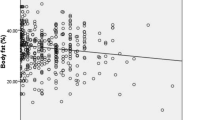Abstract
This paper examined the ethnic differences in regional adiposity, measured as circumferences and skinfolds, after controlling for the effects of some indicators of lifestyle patterns, namely, smoking, physical activity, family history of diabetes and diet, in 262 adult White and 100 migrant Pakistani (of Kashmiri origin) males in Peterborough, East Anglia, England.
Amongst individuals regularly consuming various dietary products, Pakistani men had significantly lower mean chest, minimum waist and maximum hip circumferences compared with Caucasians; they also had significantly higher mean abdomen, subscapular and suprailiac skinfolds, but significantly lower mean forearm skinfold. Ethnicity was found to have significant associations with chest (p<0.01), waist (p<0.025), and hip (p<0.05) circumferences; and abdomen (p<0.005), subscapular (p<0.001), suprailiac (p<0.025), midaxillary (p<0.05) and forearm (p<0.005) skinfolds, after removing the combined effects of smoking, physical activity and various dietary products. Results also indicated that migrant Pakistanis had significantly higher mean abdomen (+4.6 mm), subscapular (+5.3 mm), suprailiac (+4.4 mm) and midaxillary skinfolds (+3.3 mm); but significantly lower mean forearm (−1.2 mm) and medial calf (−1.2 mm) skinfolds, and chest circumference (−1.8 cm), after removing the combined effects of age, age2, smoking status, physical activity undertaken, diet and family history of diabetes. These significant ethnic differences existed even after removing the effect of body mass index (BMI).
This investigation provides clear evidence that the significant ethnic difference in regional adiposity between adult Caucasians and migrant Pakistanis of Kashmiri origin was not due to the various lifestyle indicators but may be influenced by genetic determinants. Further studies are needed to determine the nature and extent of the genetic component of this ethnic heterogeneity in regional adiposity between Caucasians and migrant Pakistanis.
Similar content being viewed by others
References
Balarajan, R. Bulusu, L. Adelstein, A.M. and Shukla, V. (1984). Patterns of mortality among migrants to England and Wales from the Indian subcontinent. British Medical Journal, 289:1185–1187.
Ballard, R. (1988). The political economy of migration: Pakistan. Britain and Middle East. In: Eades, J.E. (ed). Workers, migration and the labour market. London: Tavistock Press.
Bose, K. (1995). A Comparative Study of Generalised Obesity and Anatomical Distribution of Subcutaneous Fat in Adult White and Pakistani Migrant Males in Peterborough. Journal of the Royal Society of Health, 115:90–95.
Bose, K. and Mascie-Taylor, C.G.N. (1996). The Association between Age, Smoking, Physical Activity and Diet with Total Cholesterol in Adult Caucasian and Migrant Pakistani Migrant Males. (In Press). Journal of Human Ecology.
Bouchard, C. (1992). Genetic Aspects of Human Obesity. In: Bjorntorp, P. and Brodoff, B.N. (eds). Obesity. pp. 343–351. Philadelphia: J.B. Lippincott Company.
Knight, T. Smith, Z. Lockton, J.A. Sahota, P. Bedford, A. Toop, M. Kernohan, E. and Baker, M.R. (1993). Ethnic differences in risk markers for heart disease in Bradford and implications for preventive strategies. Journal of Epidemiology and Community Health, 47:89–95.
Lohman, T.G. Roche, A.F. and Martorell, R. (1988). Anthropometric Standardization Reference Manual. Champaign, Illinois: Human Kinetics Books.
McKeigue, P.M. Pierpoint, T. Ferrie, J.E. & Marmot, M.G. (1992). Relationship of glucose intolerance and hyperinsulinaemia to body fat pattern in South Asians and Europeans. Diabetologia, 35:785–791.
McKeigue, P.M.; Shah, B. and Marmot, M.G. (1991). Relation of central obesity and insulin resistance with high diabetes prevalence and cardiovascular risk in South Asians. The Lancet, 337:382–386.
Nicoll, A. Bassett, K. and Ulijaszek, S.J. (1986). What's in a name? Accuracy of using surnames and forenames in ascribing Asian ethnic identity in English populations. Journal of Epidemiology and Community Health, 40:364–368.
Office of the Population Censuses and Surveys, United Kingdom. (1991). H Form for Private Households. London: HMSO.
Sokal, R.R. and Rohlf, F.J. (1986). Biometry: The principles and practice of statistics in biological research. New York: W.H. Freeman.
Williams, R. Bhopal, R. and Hunt, K. (1994). Coronary Risk in a British Punjabi Population: Comparative Profile of Non-Biochemical Factors, International Journal of Epidemiology, 23:28–37.
Author information
Authors and Affiliations
Rights and permissions
About this article
Cite this article
Bose, K., Mascie-Taylor, C.G.N. Ethnic differences in regional adiposity between adult caucasian and migrant pakistani males which are unexplained by some common indicators of lifestyles. Int. J. Anthropol. 12, 63–72 (1997). https://doi.org/10.1007/BF02447898
Received:
Accepted:
Issue Date:
DOI: https://doi.org/10.1007/BF02447898



